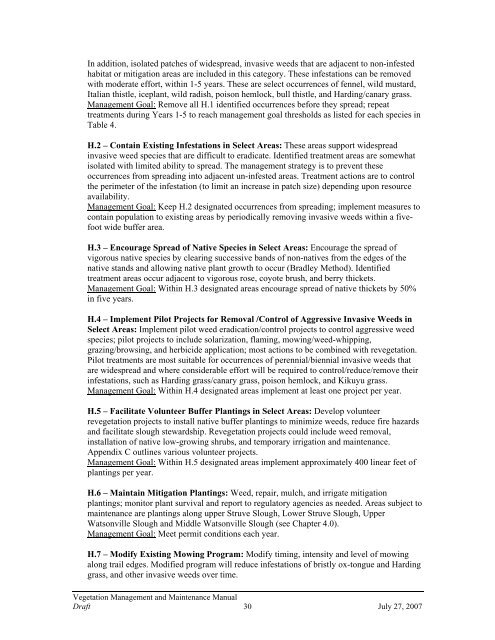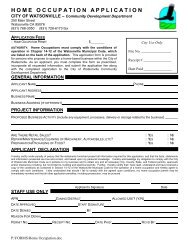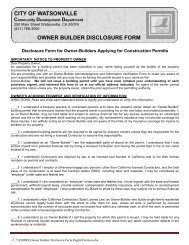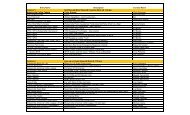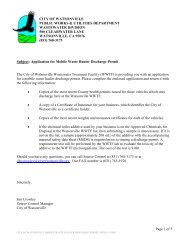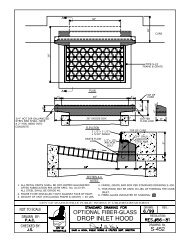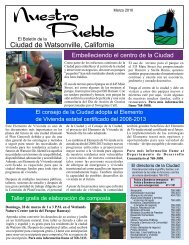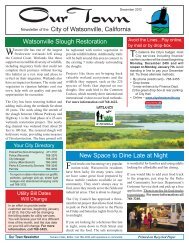Vegetation Management and Maintenance Plan - Watsonville ...
Vegetation Management and Maintenance Plan - Watsonville ...
Vegetation Management and Maintenance Plan - Watsonville ...
Create successful ePaper yourself
Turn your PDF publications into a flip-book with our unique Google optimized e-Paper software.
In addition, isolated patches of widespread, invasive weeds that are adjacent to non-infested<br />
habitat or mitigation areas are included in this category. These infestations can be removed<br />
with moderate effort, within 1-5 years. These are select occurrences of fennel, wild mustard,<br />
Italian thistle, iceplant, wild radish, poison hemlock, bull thistle, <strong>and</strong> Harding/canary grass.<br />
<strong>Management</strong> Goal: Remove all H.1 identified occurrences before they spread; repeat<br />
treatments during Years 1-5 to reach management goal thresholds as listed for each species in<br />
Table 4.<br />
H.2 – Contain Existing Infestations in Select Areas: These areas support widespread<br />
invasive weed species that are difficult to eradicate. Identified treatment areas are somewhat<br />
isolated with limited ability to spread. The management strategy is to prevent these<br />
occurrences from spreading into adjacent un-infested areas. Treatment actions are to control<br />
the perimeter of the infestation (to limit an increase in patch size) depending upon resource<br />
availability.<br />
<strong>Management</strong> Goal: Keep H.2 designated occurrences from spreading; implement measures to<br />
contain population to existing areas by periodically removing invasive weeds within a fivefoot<br />
wide buffer area.<br />
H.3 – Encourage Spread of Native Species in Select Areas: Encourage the spread of<br />
vigorous native species by clearing successive b<strong>and</strong>s of non-natives from the edges of the<br />
native st<strong>and</strong>s <strong>and</strong> allowing native plant growth to occur (Bradley Method). Identified<br />
treatment areas occur adjacent to vigorous rose, coyote brush, <strong>and</strong> berry thickets.<br />
<strong>Management</strong> Goal: Within H.3 designated areas encourage spread of native thickets by 50%<br />
in five years.<br />
H.4 – Implement Pilot Projects for Removal /Control of Aggressive Invasive Weeds in<br />
Select Areas: Implement pilot weed eradication/control projects to control aggressive weed<br />
species; pilot projects to include solarization, flaming, mowing/weed-whipping,<br />
grazing/browsing, <strong>and</strong> herbicide application; most actions to be combined with revegetation.<br />
Pilot treatments are most suitable for occurrences of perennial/biennial invasive weeds that<br />
are widespread <strong>and</strong> where considerable effort will be required to control/reduce/remove their<br />
infestations, such as Harding grass/canary grass, poison hemlock, <strong>and</strong> Kikuyu grass.<br />
<strong>Management</strong> Goal: Within H.4 designated areas implement at least one project per year.<br />
H.5 – Facilitate Volunteer Buffer <strong>Plan</strong>tings in Select Areas: Develop volunteer<br />
revegetation projects to install native buffer plantings to minimize weeds, reduce fire hazards<br />
<strong>and</strong> facilitate slough stewardship. Revegetation projects could include weed removal,<br />
installation of native low-growing shrubs, <strong>and</strong> temporary irrigation <strong>and</strong> maintenance.<br />
Appendix C outlines various volunteer projects.<br />
<strong>Management</strong> Goal: Within H.5 designated areas implement approximately 400 linear feet of<br />
plantings per year.<br />
H.6 – Maintain Mitigation <strong>Plan</strong>tings: Weed, repair, mulch, <strong>and</strong> irrigate mitigation<br />
plantings; monitor plant survival <strong>and</strong> report to regulatory agencies as needed. Areas subject to<br />
maintenance are plantings along upper Struve Slough, Lower Struve Slough, Upper<br />
<strong>Watsonville</strong> Slough <strong>and</strong> Middle <strong>Watsonville</strong> Slough (see Chapter 4.0).<br />
<strong>Management</strong> Goal: Meet permit conditions each year.<br />
H.7 – Modify Existing Mowing Program: Modify timing, intensity <strong>and</strong> level of mowing<br />
along trail edges. Modified program will reduce infestations of bristly ox-tongue <strong>and</strong> Harding<br />
grass, <strong>and</strong> other invasive weeds over time.<br />
<strong>Vegetation</strong> <strong>Management</strong> <strong>and</strong> <strong>Maintenance</strong> Manual<br />
Draft 30 July 27, 2007


